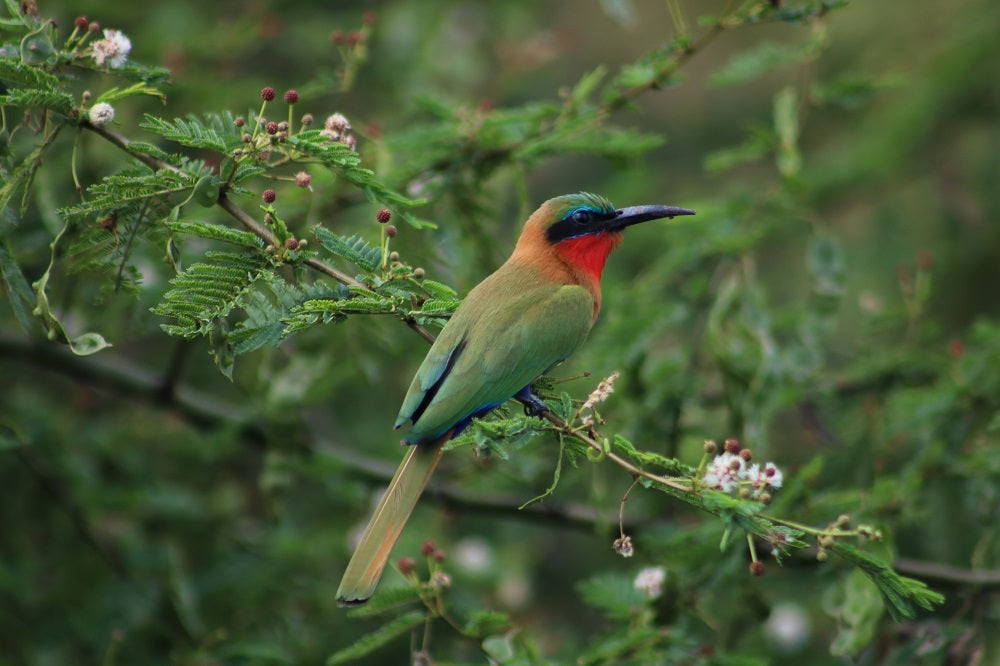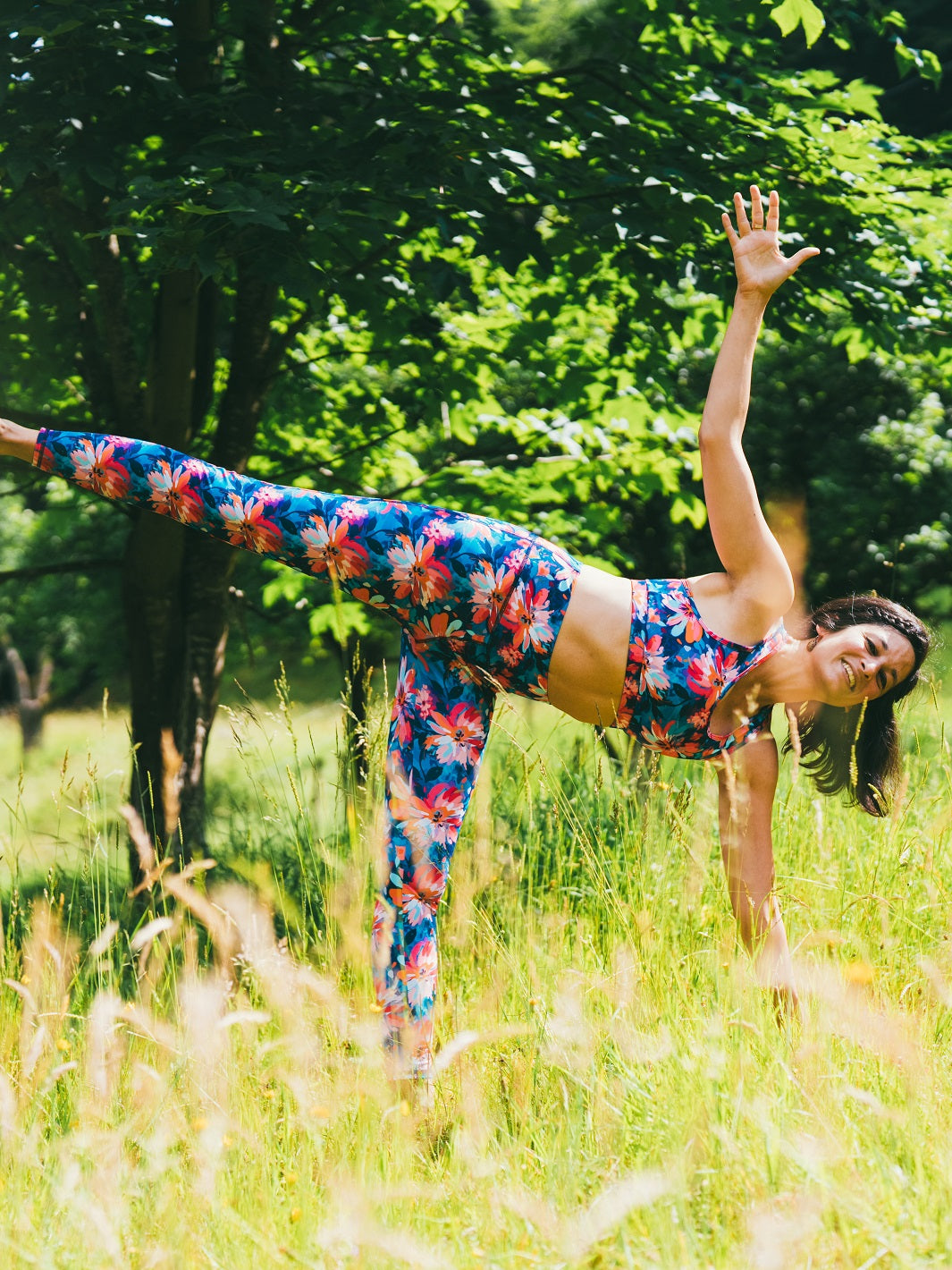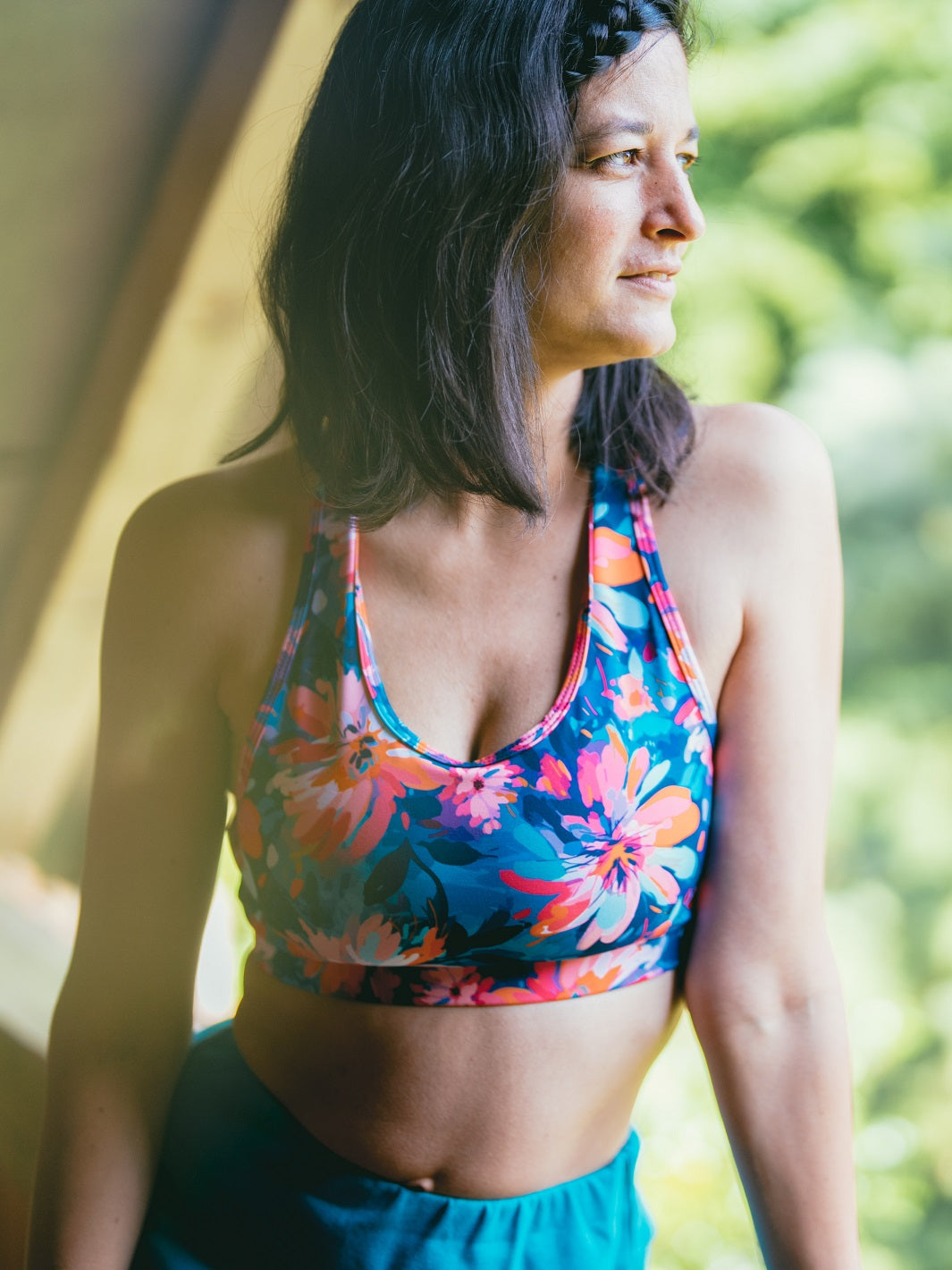By creating Géopélie, I wanted a nice brand name that subtly referred to the world of yoga…and I hope I achieved it 😉
Geopelie is the name of the smallest dove in the animal kingdom, a symbol of peace and love.
And it's also a nod to the many yoga postures that are named after birds.
Many, yes! But what are they called?
I realized with amazement that I was not able to list more than 3 and so, I wanted to do a more complete search.
Imagine that I found 13 yoga postures with bird names and which I took the time to detail below.
And you, did you know them all?
1. Eagle pose or Garudasana
Garudasana is one of the great classics and features the king of birds.
Benefits: Eagle posture softens and strengthens the joints of the ankles, hips, shoulders and wrists.
How to do the posture: starting from mountain pose, position your legs hip-width apart. Bend your knees slightly and wrap your right leg around your left leg. Come hook your right foot behind your left ankle. Extend your arms in front of you, wrapping your left arm around your right arm, with your left elbow above your right elbow. Take the time to take 5 deep breaths before reversing.

2. Crow pose or Bakasana
The crow pose is one of those postures that impresses but is not completely unattainable provided you practice it very regularly!
Benefits: the crow pose intensely uses the wrists, hands, arms and shoulders but it is undoubtedly our concentration and our balance that are put to the test. Practiced regularly, the crow posture allows a very pleasant stretching of the spine.
How to do the posture: preparing the base of the posture that our two hands constitute is essential. We will therefore take the time to place them correctly under the shoulders, parallel to each other and with our fingers well apart to maintain balance. Bend your elbows and open your knees which you will interlock at the level of the armpits. Looking at a fixed point in front of you, rock forward.

3. Stork pose or Uttanasana
This posture is also known by other names such as the standing pincer, the hands-to-toes posture or the intense stretch. This is a powerful forward bend that beginners with still a little stiff hamstrings will be able to perform with their knees slightly bent.
Benefits: The stork pose offers an excellent stretch for the back and hamstring muscles, it relieves fatigue, stress or headaches.
How to do the pose: Starting in Mountain Pose, place your hands on your hips, feet parallel to each other. On a deep inhale, swing your arms forward and on a deep exhale bend your upper body, your hands next to your feet or capping your ankles. Stretch your spine well and stay in the posture for two breathing cycles. When starting out, you can use a yoga block to place under your forehead.

4. Lark pose or Bharadvājasana
Here's a twist that looks quite appetizing to me (I love twists)! Before diving into postures with bird names, I had never heard of them. Difficult to say whether Bharadvājasana is popular or confidential although my research tends towards the second option. What do you think ?
Benefits: This deep twist tones and stretches the spinal muscles, aids digestion and relieves constipation.
How to do the pose: While seated on the floor, with both legs extended in front of you, bend both knees to the left so that your feet are on the ground next to your left hip (series I). Turn your torso to the right. Place the left hand on (version 1) or under (version 2) the right knee and the left hand next to the right buttock. Continue to twist your torso to the right and look over your right shoulder. There is another variation (series II) with one leg in half lotus and the other in hero: we grab the foot of the leg positioned in half lotus with the hand on the same side, the arm passing behind the back. The other hand is either on the knee or below.
Lark pose - Series I


Lark pose - Series II

Photo credit :
5. Pigeon pose or Kapotasana
Pretty heart-opening postures, the pigeon pose and its variations are among the most photogenic yoga postures but also those that make us grimace the most! The royal variation of pigeon pose called Raja-Kapotâsana is not for everyone .
Benefits: Excellent stimulation for the hips, the pigeon pose also allows you to stretch the thighs, abdomen, chest and shoulders.
How to do the posture: Starting in downward facing dog, raise your right leg towards the sky and bring it forward between both hands. Lower the right knee to the ground, the other leg remains on the ground, the sole of the left foot looks at the sky. While inhaling, raise your torso by positioning your arms outstretched on either side of your hips. Open your chest and look up to the sky. After a few moments in this posture, lower your torso onto your right knee, arms on the ground on either side of your head.
Variant with raised bust

Variant with the bust lying down
Photo credits :
6. Seagull pose or Bhega Kriya
Bhega Kriya reproduces the pretty curvature of the seagull's wings for a delicious back stretch. It’s a posture that’s completely accessible to beginners and experienced yoginis alike!
Benefits: Seagull pose is an excellent gentle back strengthening exercise. It also helps stretch the sciatic nerve, which is put to the test by long hours spent in a sitting position or by carrying heavy objects.
How to do the posture: While standing, place your feet forearm-width apart. Straighten your back and on an inhale, raise your arms to horizontal, palms down. As you exhale, lean your back straight forward. Flex your wrists to point your hands, fingers together, towards the ground. Hold the posture for a few slow, deep breaths, with your facial muscles relaxed.


Photo credits :
7. Vulture pose Bhasâsana or R anahadduasana
Vulture pose is an excellent preparation for turtle pose! The arms and legs gracefully reproduce the shape of the bird's wings.
Benefits: Vulture posture softens the hips, pelvis and legs.
How to do the posture: In a seated position, spread your legs wide apart. Bend your knees slightly and place the soles of your feet, toes facing forward. On an inhale, straighten your back then on an exhale, bend your torso forward, placing your elbows on the ground, your hands in prayer. There are several variations of the hand position in Vulture Pose: hands covering the feet, fingers interlaced behind the back, palm down, or hands praying behind the back.




Photo credits :
8. Heron pose or Krounchasana
The heron's posture is not the easiest and it is a safe bet that it will take you a few years before you feel completely comfortable in the skin of this bird.
Benefits: the heron pose offers a very intense stretch of the thigh muscles and stimulates the digestive system.
How to do the pose: Starting in stick pose, bend the left knee to the floor flat as in hero pose and bend the other right knee in front of you. Grab your right foot with both hands and on an inhale, slowly extend your leg toward the sky. Exhale and see if you can bring your leg closer to your torso. Stay in the posture for 5 to 10 breaths.

Photo credit :
9. Ostrich pose or Shutarmurgâsana
The posture of the ostrich has a very beautiful symbolism, that of the cosmic force of creation. Generally speaking, it would be important to identify with the animal whose posture is the representation, so here we go. Imagine being an ostrich!
Benefits: this rather intense posture works the entire posterior muscular chain, from the tips of the feet to the back of the neck. The fingers and toes are very used in the ostrich posture and can help to regain better sensitivity in these regions.
How to do the pose: Stand in a standing position with your legs a cubit apart. Slowly rise onto the tips of your toes. Place your arms horizontally in front of you. Then bend your knees while keeping your torso vertical and finally, tilt your torso forward while keeping your back flat. Lower your arms down until your fingers touch the floor. There are several variations of this posture: with the hands forward or on the ground, with one leg folded or raised towards the sky for the most advanced.


Photo credit :
10. Peacock pose or Mayurâsana
Some would get there naturally and others would work at it for years. In short, there is not much justice in the peacock pose. In the Vedic mythology of ancient India, it was Indra, the king of the Gods, who gave the peacock its flamboyant colors in gratitude for having hidden it under its pile of then brown feathers when the terrible Ravana was chasing it. The peacock posture is a beautiful imitation of the bird when it has its wings folded into a long tail.
Benefits: Peacock pose strengthens the abdominal girdle and wrists.
How to do the posture: In a kneeling position, place your elbows in the pit of your stomach, under the rib cage. Place your forehead on the ground and straighten your legs behind you, toes touching the ground. Raise your head, your gaze is far away. Shift your body weight forward, contract your abdominal muscles and push firmly on your hands. Fly into peacock pose, raising your feet horizontally.

Photo credit :
11. Rooster pose or Kukkutasana
Rooster pose is one of those postures that is as impressive as it is difficult. To achieve Kukkutasana, one of the prerequisites apart from a long yoga practice is to master the lotus posture. Because in fact, the posture of the rooster strangely resembles a levitating lotus.
Benefits: Rooster pose strengthens the muscles of the arms and shoulders.
How to do the posture : Starting in lotus pose, slide your arms between your thighs and calves, palms on the floor and fingers apart. Raise your body to knee level.

Photo credit :
12. Himalayan Duck Pose or Karandavasana
Who knew it was hard to be a duck? Karandavasana is not a posture for beginners and can give a hard time to those who practice it. But what satisfaction once you manage to place your knees lotus behind your arms. The posture of the Himalayan duck is somewhat similar to that of the rooster with the difference that the arms are positioned outside the lotus. An integral part of the second series in Ashtanga, the Himalayan duck posture is a mix between the lotus and crow posture.
Benefits: This very intense posture develops arm strength and a sense of balance.
How to do the posture : Starting in lotus pose, place your forearms flat in front of you, palms facing the floor. Shift your body weight forward and hook your knees above the elbows and straighten your arms.

Photo credit :
13. Goose pose or Chakravâkâsana
Goose pose is also known as cat balance. A posture that doesn't look like much and yet it's not the easiest!
Benefits: this posture strengthens the spine.
How to do the pose : Starting in tabletop pose, raise your left leg back on an inhale. The leg remains parallel to the ground. On the next inhale, extend your right arm forward, also parallel to the ground. Stay in the posture for a few breaths. A variation of goose pose involves raising your leg and arm on the same side. Attention balance lovers!

Photo credit :
If you know of another yoga pose named after a bird, share it in the comments 👇
Would you like to practice yoga on a daily basis but don't know what type of yoga to start with? Find out which yoga is right for you and what the benefits of this centuries-old discipline are. And to see things a little more clearly, discover the 5 different categories of yoga postures.
Discover here our eco-responsible yoga outfits made in France from recycled materials, perfectly suited to practicing all types of yoga!
And to not miss any news from Géopélie, subscribe to our newsletter here at the bottom of the page 👇 we only send a maximum of two per month!
Sources:
- Thanks to Yantra Eklablog for the inspiration!
- Yoga Journal France
- Yoga Ooreka
- The Parisian Amazons
- Technical Yoga
- Yoga Laboratory







Fallen or Humble Flamingo pose
(Vineeta Rajahamsasana)
Leave a comment